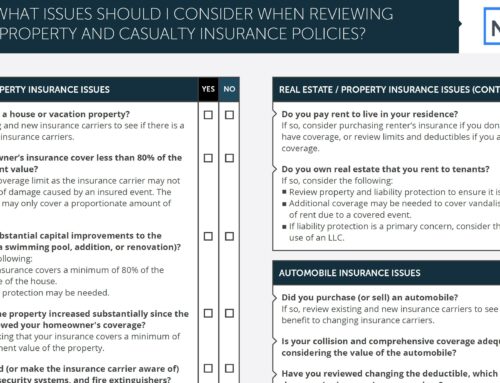Long-Term Care: Why Everyone Needs A Plan
Introduction
October is Long-Term Care (LTC) Planning Month. While no one likes to think about getting older and needing long-term care, it’s incredibly important to have a plan. As they say, an ounce of prevention is worth a pound of cure. It’s much easier to execute a well thought out plan than it is to determine what your going to do and do it during a crisis. This is why everyone should have a plan.
According to the U.S. Department of Health and Human Services, about 70% of people turning age 65 can expect to use some form of long-term care during their lives [1] with about 48% needing paid care. While most paid care episodes are relatively short, 24% of older adults can expect to need paid care for 2 years or more. Only about 15% spend more than 2 years in a nursing home. The one outlier is those older adults that develop dementia. Stays in memory care tend to be longer than normal nursing homes.
Options for Long-Term Care
Home Care
Home care has grown in popularity since the pandemic. These services can vary from personal care like bathing and dressing and meals to skilled medical care, depending on the clients needs. Many people prefer this options to having to go to a facility. The national median hourly rate for a home health aide was $23 in 2021 [1]. At 6 hours per day, the cost would be about $4,000 per month (similar to assisted living costs). It’s also important to understand the level of care needed and ensure that home modifications, if required, are feasible.
Assisted Living Facilities
Assisted Living is a blend of housing, personal care services, and healthcare tailored to individual needs typically in a residential setting. The national median monthly rate for assisted living was around $4,000 in 2021 [1]. It’s important to understand what’s included in these charges. You’ll want to read reviews, make multiple visits, and check for accreditation and licensing to ensure the facility is right for you or your loved one.
Nursing Homes
Nursing homes provide 24-hour supervised care with meals, activities, and health management. In 2021, the national median rate for a private room in a nursing home exceeded$8,000 per month (over $100,000 annually) [1]. Ensure the facility meets quality standards, and understand the staff-to-resident ratio. You’ll also want to understand the type and number of activities the facility provides. You may also want to understand if the nursing home can provide all levels of care (memory care, two-person assist, etc) to know if you might have to move again.
Alternative Options
There are other options that you should be aware of that can also provide aging support. There are adult day care programs that can provide care, typically during the day, allowing the care giver to work or do errands or just get a break. This is a good option for those who need care only during specific hours.
Additionally, continuing care retirement communities offer a spectrum of care from independent living to nursing home care in one community. These can be ideal because it won’t require you to move should you need a higher level of care. There are also short-term rehab facilities that focus on getting the patient back to their home and community after a medical event.
Why Planning Early Is Important
Early planning for long-term care is incredibly important. The number one benefit is the peace of mind that you’ll get from knowing you have a plan. Early planning also enables more choices. That could be both in the number or type of facilities (many places have long waiting lists) and at-home options, in ways to pay for your care, and the ultimate cost of care. Lack of preparation can lead to higher stress levels and limited options if care is needed in the very near term.
The Plan – H/T Carolyn McClanahan
The 3 primary things needed in a long-term care plan are…The people, the place, and paying for care. Here are some questions to consider for each.
The People
- Who will help with my care?
- What consideration or compensation will be provided?
- What outside support will I need?
- Who will pay for the care?
It’s important that these get documented. If relying on family members, it’s important to take into account their needs. If a child is going to have to quit their job or significantly scale back their ability to work, are they being compensated? Will this be reflected in any inheritance if the support isn’t being split evenly between all children?
The Place
- Where will care take place?
- Client’s home? Caregiver’s home? Facility?
- Is the home aging friendly?
- If not, can you fix it?
- When is the client willing to move?
- Are services/people to support available at the preferred location?
Many people would prefer to stay in their own home. This can be fine to a point, but there should be a discussion about what happens when the person is a danger to themselves or others or the caregivers can no longer support the level of care needed. The costs of home health care do reach a cross-over point where it is cheaper to go to a facility versus paying for hourly help.
Paying For Services
- Savings
- Long-Term Care Insurance
- Family Assistance
- Government Benefits
- VA
- Medicaid
- State Programs
We’ll cover these topics in depth in our next article Paying for Long-Term Care (Link).
After Plan Completion
Once you’ve built and documented your plan, it’s critical to communicate them with all who may be involved. It’s far too common that in a crisis the person whose wishes weren’t known will have some treatment or procedure or decision, they probably wouldn’t have wanted.
Next week’s article will dive deeper into the paying for services options and the recent legislative push from states to require long-term care insurance or add an additional payroll tax to fund long-term care.
References:
[1] U.S. Department of Health and Human Services. “How Much Care Will You Need?” LongTermCare.gov.




